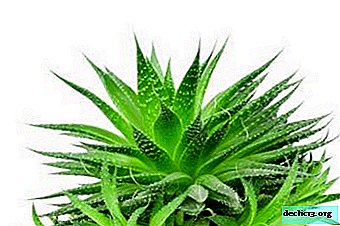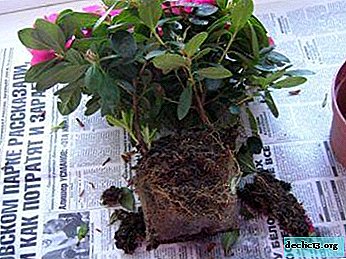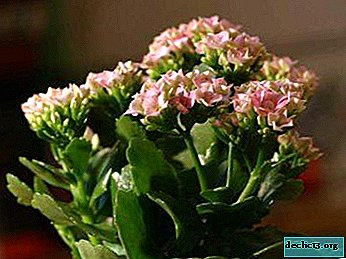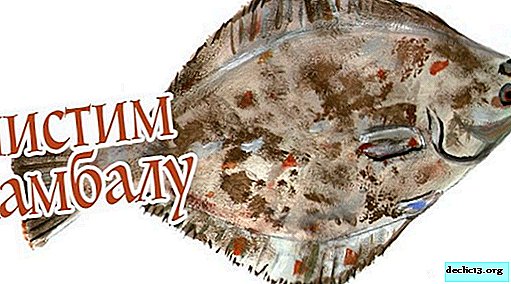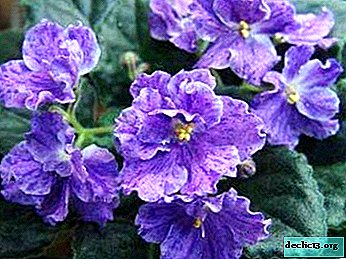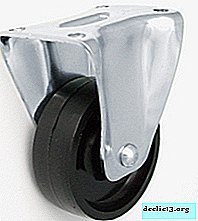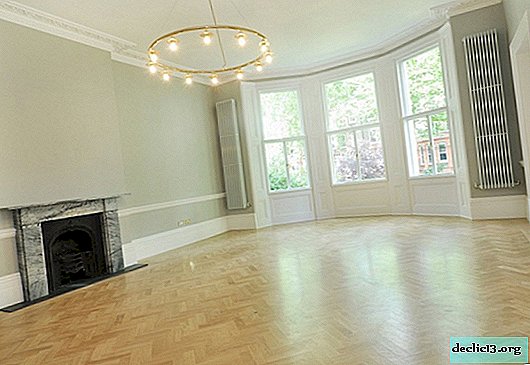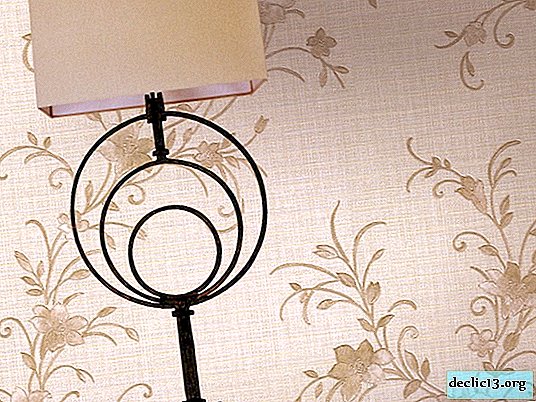Acquaintance with the climbing rose of the Jasmine variety. Practical tips for growing terry beauty
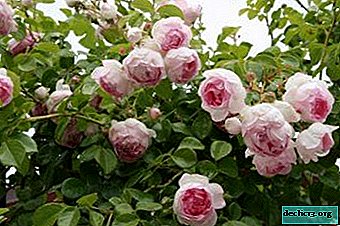
Roses, climbing varieties, occupy a leading position in vertical gardening.
They are indispensable for the construction of decorative columns, the creation of flower arches, the design of green building facades.
It is advisable to grow them in warm areas of the country where you do not need to cover plants for the winter.
In the article, we will examine clearly in the photo what this variety of roses looks like, and also learn how to properly care for them.
Description
Rose climbing Jasmine (Jasmina) - a bright representative of its subspecies. The plant is plentifully flowering. Terry inflorescences, bright pink closer to lilac or lavender. The reverse side of the petals is dark pink. The buds are tight, with 75 petals each. The shape of the inflorescences is cup-shaped. Their diameter is about 10-15 cm.
The leaves have a deep green color, medium size, thick, the surface is glossy. Powerful bush with strong, prickly shoots. The lashes are thin, they have 7-10 pieces of flowers that elegantly sag under their own weight. The height of the bush is 2.5-3 meters, and the width is 1 meter. The flowering of jasmine roses is plentiful, long, phased. The variety is resistant to diseases, rain, heat. Frost resistance zone 6.
Photo
Next, you can find a photo of Jasmine roses.



History of occurrence
Selection production W. Kordes Sohne is considered a family business, the founder of which is Wilhelm Cordes. Former sailor founded in 1887, a company engaged in growing rosna sale. However, at the end of the First World War, he revised his views, having read many books on rose breeding, and began to develop his own varieties.
The hybrid, obtained at random, had super hardy characteristics. was resistant to disease. This variety became the ancestor of a large class of climbing roses, and was named Kordesii. Years later, William's son continued his work and became the author of more than one hundred varieties. Climbing rose Jasmina was also bred by a German breeding company in 2005.
Distinctive features of the variety
A feature or characteristic of the Jasmina rose is its incredible fragrance. The smell emitted by the flower has a rich aroma of jasmine, which is felt at a distance, but small. A light, pleasant jasmine note combined with beautiful flowering - that's why flower growers love it.
Bloom
The budding period of this beauty begins in late Mayearly June. The first flowering lasts about a month and a half. There are many inflorescences, everything is fully revealed. In the sunlight, the color fades a little, burns out. Throughout the growing season, new shoots grow, and buds immediately appear on them. At the end of August, closer to autumn, it is time for a second flowering. It is not as magnificent as the first. Single brushes bloom. It lasts about two weeks.
Care before and after
 Care for the climbing rose before the onset of flowering consists in systematically loosening the soil, removing weeds, fertilizing, pruning. In the spring, they are fed with nitrogen fertilizers to enhance growth, and closer to the moment of budding, potassium fertilizers are used.
Care for the climbing rose before the onset of flowering consists in systematically loosening the soil, removing weeds, fertilizing, pruning. In the spring, they are fed with nitrogen fertilizers to enhance growth, and closer to the moment of budding, potassium fertilizers are used.
After flowering, the climbing rose must be correctly cut. Remove dry inflorescences, inanimate, damaged whips, if there is a need to thin out the overgrown bush. After feeding the plant with potassium-phosphorus mineral fertilizer.
After autumn bloom on each lash leave one or two flowers, so that the fruits are tied. Thus, the shoots will overwinter better, gain strength, and the next year will bloom profusely.
What to do if it does not bloom?
There are many reasons for the lack of flowering, for example, as a result of:
- incorrect trimming;
- poor soil quality;
- an excess of nitrogen fertilizers;
- the wrong place to land;
- bad wintering.
To restore flowering, you should determine the cause and take appropriate measures.
Step-by-step care instructions
Rosa Jasmina (Jasmina) requires specific cultivation activities, which subsequently affect growth and flowering.
A place
For the queen, the most central place in the garden is suitable, so that she can be seen from everywhere. Roses love light, but if they are in the sun all day, they will quickly fade. Therefore, it is advisable to choose places where the flower will be in the shade for half a day. They do not recommend planting roses in the lowlands, stagnation of water and air is possible there, which can provoke the development of diseases.
What should be the soil?
Flowers grow well in fertile, loose, light soil. Heavy clay soil is not suitable. Sandy lands are also not suitable for growing climbing flowers, due to their infertility and lightness. To obtain the desired result, planting soil should be diluted with peat, sand, compost. The optimal pH of the soil is 5.5-6.5. The root system of the rose Jasmine (Jasmina) is well developed, it goes deep underground. Therefore, it is very important to know the groundwater level on the site.
Important. The permissible depth is at least 1 meter.Landing
 Most an appropriate period for planting with an open root is spring or autumn. Flowers in containers are allowed to be planted at any convenient time when the outside temperature outside the window is positive.
Most an appropriate period for planting with an open root is spring or autumn. Flowers in containers are allowed to be planted at any convenient time when the outside temperature outside the window is positive.
Properly planted cuttings so that the neck was below the ground by 3 cm, which prevents drying out or freezing. Place bushes at a distance so that they do not interfere with each other. The transplant procedure must be performed in calm, cool weather, preferably in the evening. After a new plant should be watered, a sufficient amount is 20-30 liters.
Temperature
Jasmine Rose is a frost-resistant variety, therefore, it can withstand a minimum temperature of -23 ° C. In summer, the maximum parameters are + 35-40 ° C, but they adversely affect the state of the plant. Flowers look oppressed, leaves curl. The optimum temperature range is considered to be + 20-25 ° C.
Watering
In dry moments, be sure to water with cold water about 15-20 liters under the bush. If there is no rain for a long time, moisten the rose twice a week. With the onset of autumn, minimize watering and completely remove it by the end of September.
Pruning
For Jasmine, spring pruning is recommended, which implies the elimination of dry, damaged or fattening lashes, as well as thinning or crown formation. In addition, pruning contributes to a uniform coverage of the object, next to which a rose is planted. First of all, this process is aimed at the development of new vegetative sprouts, because inflorescences appear on last year's shoots.
How to tie plants?
Another important point regarding climbing roses is tying. However, this is not possible without special support. It is important to build a design for curly flowers, thanks to which they will develop correctly. Supports can be in the form of: arches, grids, conical structures. To them with the help of small ropes attached climbing branches.
Transfer
 An adult plant needs a transplant if the previous place did not fit for any reason. It is advised to perform it in early autumn, until the roots begin to adapt to the cold, or in early spring before the appearance of the buds. To do this is:
An adult plant needs a transplant if the previous place did not fit for any reason. It is advised to perform it in early autumn, until the roots begin to adapt to the cold, or in early spring before the appearance of the buds. To do this is:
- Carefully dig out the recess and carefully remove the flower.
- Inspect the root system and leave healthy, dense shoots, remove excess ones with secateurs.
- When planting a plant, it is necessary to spread the roots in a new pit so that they do not stick up.
- Then cover with earth and water.
Preparation for winter
Rose climbing Jasmine (Jasmina) for the winter requires mandatory shelter. However, before stable cold weather, no action is needed. The flower can withstand temperatures up to -7 ° C. In addition, small frosts only help adaptation and hardening of the bush.
- Planks, polystyrene are laid on the ground, and then the bush is bent, pinning it with pegs.
- Shelter of flowers, as a rule, with spruce spruce branches or pine needles.
- In early spring, the side flaps are ajar for ventilation.
Step-by-step instruction: how to propagate?
Rose Jasmine (Jasmina) propagates vegetatively. This is the only way to preserve all varietal qualities.
- After the first flowering in the summer, cuttings are harvested.
- Need a young, fat escape with 2 internodes.
- Use a sharp knife to make the lower cut at 45 °, and the upper straight above the kidney.
- Deepen the shank by 1 cm in wet sand, cover with a jar or polyethylene from above.
- Leave as it is until the roots appear.
Diseases and Pests
Based on the observations of experienced gardeners, we can say that rose Jasmine (Jasmina) virtually no disease, it is resistant to frost and other adverse weather conditions. The only thing that can provoke a painful condition is aphids. These are small sucking insects that can be dealt with by means of a soap solution or any insecticide preparation.
Jasmina, a climbing rose, is a variety of so-called "nostalgic roses" created in the style of popular English subspecies. The magnificent pink bush surprises not only with its appearance, but also with the incredible aroma of jasmine. With proper care and a good place to plant, the plant can live for more than a dozen years.

